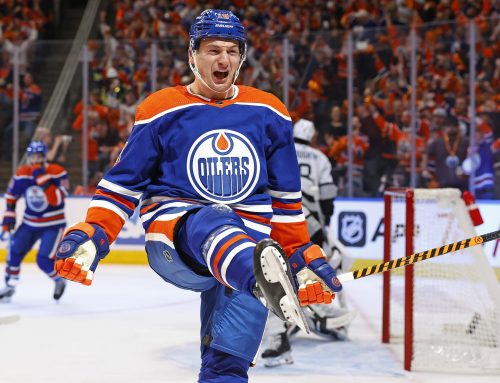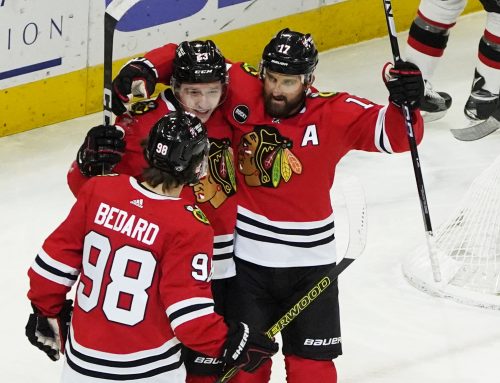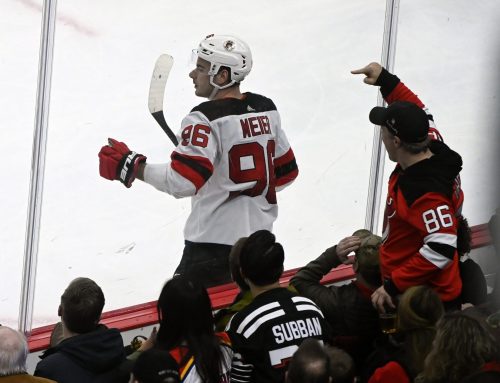Ramblings: Sens Rout Pens, Chris Wideman, Blackhawks Fantasy Performers – May 18
Michael Clifford
2017-05-17

Senators take a 2-1 series lead, Chris Wideman, and thoughts on Blackhawks fantasy performances
****
Pittsburgh-Ottawa
It was a perfect start for Ottawa, as Mike Hoffman corralled a puck behind the net and banked it in off Pittsburgh netminder Marc-André Fleury’s right pad and in the net less than a minute into the game. About two minutes later, Marc Methot pinched down and his shot rebounded off defenceman Ian Cole, and Fleury kicked the puck into his net trying to recover. Two minutes after that, Derick Brassard made it 3-0 for the home team. Thirty seconds after that, Zack Smith made it four nothing on a wrap-around, and that was the end of Fleury’s night. It was, in essence, the end of the night for Pittsburgh as well.
Naturally, Erik Karlsson will always stand out on the Ottawa blue line, and Dion Phaneuf is the secondary offensive option back there. Chris Wideman, however, is someone that impressed me in this game, and he really has for most of the year. He’s certainly not used as one of their top options, playing under 14 minutes a game each of the last two seasons, but he appears to have good offensive instincts. Over the last two regular seasons, he’s top-10 among defencemen in shots on goal per minute of five-on-five play, ahead of guys like Dustin Byfuglien, Colton Parayko, and Roman Josi. His defensive game needs work, and at 27 years old, it’s a wonder how much he can improve, but perhaps he can be used more in sheltered minutes with some secondary power play time. Something along the lines of how Pittsburgh used Justin Schultz when their defence corps was healthy. Wideman isn’t worth much in the fantasy game now, but he could flourish with a bigger role.
****
Chicago Blackhawks
Throughout the summer, I will be review the fantasy seasons of certain players on a team-by-team basis. The next squad on the list, by alphabetical order, is Chicago. I’m going to skip both Patrick Kane and Artemi Panarin because despite their excellent fantasy seasons, there wasn’t anything unique about them. They did what most expected them to do.
Ryan Hartman
There are other players worthy to be listed first, but Hartman is probably the most interesting fantasy own on the team. Allow me to explain.
A couple of weeks ago in a Ramblings, I discussed how there may be a breakout season on the horizon for Brett Ritchie based on shot rates and a hopeful increase in ice time. Other players fit the same criteria, and one of them is Hartman. Among the 262 forwards with at least 750 five-on-five minutes in the 2016-17 regular season, the rookie finished 28th in individual shot attempts per minute, finishing in the same range as guys like Tyler Seguin, James van Riemsdyk, and Jakob Silfverberg. He also finished second in shots on goal (170) among forwards with under 1000 minutes in total ice time (Brendan Gallagher had 187).
Racking up shots is nothing new for Hartman: over his previous two season in the AHL, he managed 344 shots in 130 regular season games. His 28 goals in those AHL games, however, is just an 8.1 percent shot conversion rate. That raises a concern whether his 11.2 percent in the NHL this past campaign at all strengths was a mirage, or an effect of playing with talented players.
Below is a list of the top-15 forwards in individual scoring chances per 60 minutes at five-on-five (minimum of 850 minutes played, via Corsica Hockey). The left winger in question had no problem in this regard:

He shot 8.7 at five-on-five with all those scoring chances, and an average shot distance (27.32 feet) similar to Artemi Panarin (27.70 feet). It should be noted a few other players that generated scoring chances as often as him had low conversion rates as well (Zach Parise, Nick Ritchie) but most were over 10 percent.
It is a safe assumption that Hartman’s 19 goals this past year was not a mirage, but rather an indicator of things to come. Individual scoring chances is far from an end-all, be-all when it comes to future performance, but it’s a good sign that he’s not wasting shots from the outside as some players tend to do.
Of course, there’s the issue of lineup placement. If he continues to toil in the bottom-6 as he did much of last year, there won’t be a breakout fantasy season. Power-play time is another matter, as well. However, we saw Marian Hossa spend a good chunk of time towards the end of the season on the third line, and if that trend continues next year, that opens a spot for Hartman. Either way, training camp in Chicago should provide us with some insight, and things change often under Joel Quenneville. If given the opportunity, however, Hartman seems primed for an offensive breakout.
Through the end of December, Toews had an 82-game pace of 49 points. He turned things around, and had he played the full season, he would have almost certainly cracked 60 points. That’s a solid season, but depending on the type of league, he was probably drafted in the 50-75 range, and that didn’t pay off.
What is curious to me is his 10.6 percent shooting. That is the lowest of his career, the only time he’s been below 12.4 percent in a season, and considerably lower than his three-year average of 14.9 percent. This is important because it was his fourth straight season without cracking 200 shots on goal, so if he doesn’t shoot with volume, he needs to convert at a high rate to be productive in the fantasy game.
Per Corsica, Toews had his lowest average shot distance in three years (21.9 feet). That is a good sign for his shot percentage to turn around in 2017-18. He also managed a three-year high in individual scoring chances per minute at 2.52 – not a great number, but good for his recent performance. That is all in conjunction with an uptick in shot rate per minute, so while he was doing the things we like to see to generate more offence, the puck wasn’t going in like we hoped.
It is certainly possible that next year Toews gets back to what we expect him to be, and that’s a player with 25-plus goals and 35-plus assists. It is time for him to be correctly slotted, however. In standard roto leagues, he’ll be fortunate to crack the top-50 with the above stat line and his typical peripherals. In a 12-team league, where he to slide to the sixth or seventh round, that is when he warrants consideration. Any earlier than that seems like a waste.
Following a scorching start to the season where Crawford had a .928 save percentage through New Year’s Day, he managed just a .911 the rest of the way. On aggregate, a .918 season is nothing to sneeze at, but it is a step down from the back-to-back .924 seasons he had before. He also had a 2.55 goals against average, a five-year high.
That last point is the most important here. Goals against average, by and large, is a team stat, not a goalie stat, regardless of how it’s commonly used. Save percentage relies on the ratio of shots saved (that’s on the goalie) whereas goals against average is largely relies on the volume of shots faced (that’s on the team). That is why Pekka Rinne’s regular season GAA was a quarter-goal better (2.42) than Frederik Andersen (2.67) despite identical save percentages (.918).
One thing that contributes to this problem, also, is the penalty kill. Despite Chicago being relatively close to what they had done the previous two seasons in shots against at five-on-five, their penalty kill was among the worst in the league. As a team, they allowed the second-most shots per minute while shorthanded, and the ninth-most scoring chances. Those numbers are similar to what they managed in the 2015-16 season, but Crawford’s shorthanded save percentage took a hit anyway. Small samples (like one season of shorthanded save percentage numbers) are unreliable, but a team that constantly gives up scoring chances in this situation year after year is unlikely to find success.
The underlying numbers for Crawford like five-on-five save percentage, and high-danger save percentage (as defined by Corsica) were pretty much in line with what he did the couple seasons prior. If the team can tighten up their penalty kill, he could be in for a very nice rebound next year, which would mean a good value at the draft table. I haven’t started official rankings for the 2017-18 campaign, but grabbing him anywhere outside the top-5 goalies drafted would be a solid move (for now).





 NYI
NYI CAR
CAR T.B
T.B FLA
FLA TOR
TOR BOS
BOS VGK
VGK DAL
DAL EDM
EDM WSH
WSH L.A
L.A COL
COL VAN
VAN WPG
WPG NYR
NYR NSH
NSH ANA
ANA DET
DET
